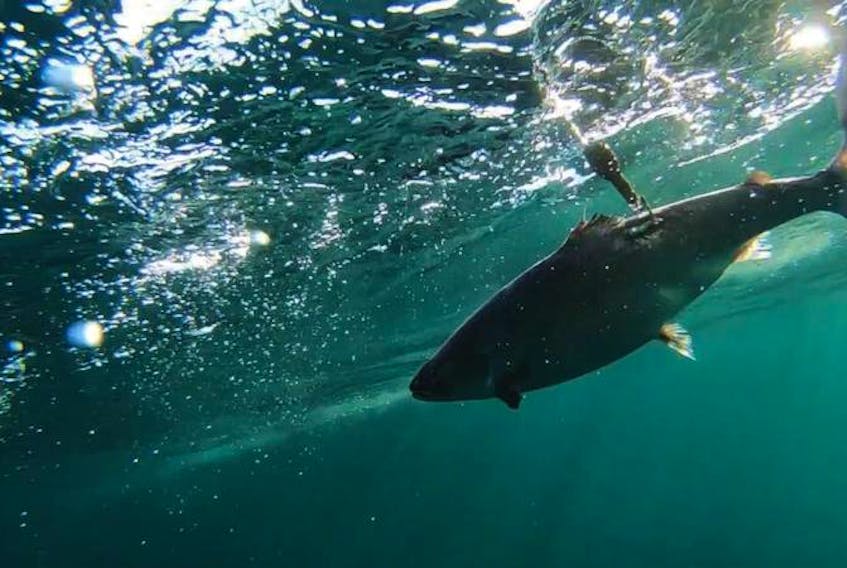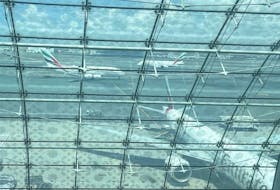Raymond Elliott rounded the point off Goose Cove and steamed his skiff into a bay of memory.
The boat’s motion changed as it left its brief sojourn in the North Atlantic’s slow swell for the slap of the shorter wind-driven waves of Hare Bay against its spruce plank.
It was a warm June morning in 1990 and the St. Anthony, N.L., fisherman was heading to haul the lumpfish nets he still set off Locke’s Cove — the community he’d been resettled out of in 1967.
“My entire life (up till then) you’d have had to pick your way carefully to avoid getting your prop fouled up in someone’s salmon gear,” said Elliott, now 82.
“Not a buoy on the water, it made me want to head back to the wharf and hang my oil clothes up for good.”
For as long as the Irish and English immigrants had lived in homes they’d built around Hare Bay, at the northern peninsula’s tip, they’d set nets to catch the salmon that came mid-June to feast on capelin.
The previous year the commercial fishery for salmon, one of Canada’s last, had been closed.
To Elliott, it was the end of a world — his own. As a child, his job had been to behead and gut the salmon they salted and packed into 100-pound wooden barrels.
“The capelin would be packed into their bellies just as tidy as sardines in a can,” said Elliott.
A family crew could expect to pack and sell 20 barrels between mid-June and mid-July of the larger salmon, which had come from rivers far away to feed on capelin, and four barrels of the smaller salmon that were likely destined for the spawning brooks around Hare Bay.
“Nothing makes sense,” said Elliott.
“Catches for us had been steady right till the end. They used to run logs down Main Brook and that didn’t seem to slow them down. Then they close the fishery and they tell us they’ve dropped off.”
Healthy system, healthy fish
Nothing does make sense, at least not yet, about what has been happening to Atlantic salmon since 1990.
Until 1989, an estimated eight to 12 per cent of Atlantic salmon survived their journeys from home rivers to northern waters off Labrador and Greenland, to then come back and spawn.
In 1990, that plummeted to between one and four per cent.
The total population crashed too — from an estimated eight million salmon alive on either side of the Atlantic to between one- and two-million fish.
It hasn’t gotten better since.
“The timing of that is concurrent with the major cod collapse and a major shift in oceanographic and climate patterns,” said Edmund Halfyard, a research scientist for the Nova Scotia Salmon Association.
“We’ve seen evidence of this shift in everything from phytoplankton and capelin up to large commercial fish species and even predators like gannets and seals. Everything shifted at about the same time period. It’s a new ocean.”
This story isn’t about gannets or cod, although they’re important too.
It’s about salmon because their lives rely on both the health of land and sea.
They are anadromous — morphing their own biological needs to freshwater to breed in gravel bottomed tributaries, fed by drops of rain falling one at a time on our forests, then back again to swim out estuaries through bays and gulfs and finally into the North Atlantic to feed.
An Atlantic salmon needs healthy systems all along its route to complete its own personal odyssey.
Though man’s threats were initially in its rivers, the danger appears to have shifted oceanward.
On last Saturday, Jonathan Carr of the Atlantic Salmon Federation was in Qaqortoq, Greenland, trying to find out why.
Greenland banned the export of salmon in 1998 but maintains a small market/personal use commercial fishery with a 20-tonne quota.
“Not by any means is that fishery the reason for the decline in the oceans,” said Carr, vice-president of research for the federation.
“That fishery hasn’t changed a whole lot over last several decades.”
The arduous journey
It was only in the 1950s that the rest of the world discovered the Atlantic salmon feeding off the coast of Greenland. The commercial fishery reached its height in 1971 when 2,689 tonnes of salmon were caught there.
It was scientists who pieced together where the fish were coming from. The answer — they come from everywhere.
Genetic testing has shown that the salmon arriving at southern Greenland to feed on capelin and herring come from both European and North American rivers. They are predominantly older, larger fish — many of which have already spawned once — that make the long trip.
Younger fish, typically less than 63 centimetres long, usually make the arduous journey to the Labrador coast, while salmon from the Bay of Fundy’s rivers will sometimes spend their first year at sea feeding in the Gulf of Maine.
“Greenland is one of the last stages of the life cycle for many Atlantic salmon,” said Carr.
“We’re trying to create a map of where they go, what they do and where they die with the goal of ultimately finding out what’s happening. Whether there’s anything we’ll be able to do about it when we find out remains to be seen.”
He and colleagues from the American National Oceanic and Atmospheric Administration, guided by members of Greenland’s Association of Fishers and Hunters, are catching and fitting large salmon with pop-up transmitters.
The devices record location, depth, water temperature and salinity before they release eight months later and float to the surface to beam the data via a satellite to Carr’s New Brunswick office.
They’ll then share that data with oceanographers, biologists and other scientists versed in what’s going on beneath the waves.
That’s where they hope to find answers instead of hypotheses.
Because there’s already a lot of the latter — 63 hypotheses have been published about what may be responsible for salmon not returning home.
They range from the ever northwest trek of magnetic north throwing off the salmon’s navigation to the broad changes wracked on the ecosystem by climate change.
Then there are the localized trends that explain trouble at individual rivers.
Though this is the first of a four-year project tagging salmon off Greenland, the Atlantic Salmon Federation began tagging smolts in rivers around Atlantic Canada in 2003.
Receiver stations placed around estuaries, across the Cabot Strait (between Cape Breton and Newfoundland) and the Strait of Belle Isle (between Newfoundland and Labrador) by Halifax-based Ocean Tracking Network, showed how far the salmon got.
They found fish, from as far away as Maine, congregated in the Gulf of St. Lawrence, schooled with salmon from the rivers of Nova Scotia, Prince Edward Island and New Brunswick that passed each year through the Strait of Belle Isle over a 10-day period in each July.
While survival out of the estuaries has been high — typically ranging from 65 to 70 per cent — there have been outliers.

Prior to 2012, survival out of the Miramichi River was 70 per cent too, then it dropped to the low 20 percentile and has stayed there.
“We’ve been able to attribute some of that mortality to striped bass — it was during the same time period that striped bass increased from about 5,000 to close to a million fish,” said Carr.
The striped bass that spawn in the Miramichi show up outside rivers around the Gulf of St. Lawrence to feed — juvenile salmon smolts on their first trip into the open ocean are on the menu.
Antigonish harbour is one of the estuaries where the striped bass have been showing up in force.
But despite the rise in striped bass numbers, the three salmon rivers feeding Antigonish Harbour — Wright’s River, South River and West River — all have seen their salmon runs increasing since 1990.
On a recent cold Thursday morning, Nicholas MacInnis was perched atop a broken concrete casing that once impeded fish from swimming up the Wright’s River.
An excavator hired by the Antigonish Rivers Association, of which he is president, tore it up this summer. The town drilled a route under the river for a replacement water pipe to feed homes on the other side.
Below MacInnis’ feet the Wright’s River flowed freely once again. He’s not sold on the argument that salmon’s great threat is at sea.
“The ocean is this vast thing to study and so little is known that you can go down a rabbit hole for a long time looking for answers,” said MacInnis.
“There is an issue in the ocean but where we are seeing returns is where we’re doing the work.”
For the past decade, his association has been raising money at an annual dinner — this year’s event is an $80 a plate chicken dinner on Saturday at St. F.X.’s Bloomfield Centre — and using it to undo some of man’s changes to the rivers feeding into the harbour.
Along previously cleared banks of the three rivers, they’ve planted long-lived hardwoods and softwoods, like sugar maple and red spruce, to provide cool shade for salmon. They’ve placed logs in the water to simulate large fallen trees that dig themselves into the bottom and create pools for the fish to rest.
He points to Brierly Brook, which begins on Brown’s mountain and runs through land cut for pulp and paper, past farms cleared to the water and finally through a town to join with the West River. When the association began its work in the area in 1995 they were only able to find 40 redds — a spawning nest in fine gravel where a female salmon has laid her eggs — up Brierly Brook. Within seven years they were counting 600-800 redds in Brierly Brook.
On the Eastern Shore, they’ve seen success on a different West River. This one runs into Sheet Harbour.
This West River, like all the other rivers along the Eastern Shore, fell victim to acid rain during the latter half of the 20th century.
Nova Scotia could be considered the tailpipe of North America’s industrial heartland — the air pollution that spewed there fell on us as rain.
The Eastern Shore’s thin soil over granite shoulders was stripped of its ability to buffer the acidity and the rivers in turn became toxic to salmon.
The 1990 Clean Air Act signed by Canada and the United States has drastically reduced the pollution coming our way, but the damage was already done.
“Our soil still hasn’t recovered,” said Edmund Halfyard, the research scientist for the Nova Scotia Salmon Association, who is also project manager for the West River.
“The marine environment is important but too many people make the mistake of separating the environments,” said Halfyard.
Hence the three-and-a-half-storey lime storage silo on the West River. With only about 3,500 smolts leaving the river annually, Halfyard’s association built the facility in 2005 to mix pelletized lime into the river and lower its acidity — much like some do on their lawn.
The results were remarkable — within 10 years they were counting 12,000 smolts leaving the West River. When they finally get home, Atlantic salmon are prodigious spawners.
A 12-pound adult female can lay about 8,000 eggs.
So large numbers of healthy smolts leaving a river doesn’t mean a lot are coming back.
Despite the large runs of smolts, they’ve only counted about 70 fish returning to the West River annually.
Even our victories are sad when viewed against what once was.
“It is difficult to envisage today what this vast region of virgin land was truly like, as most of our present wilderness area is only wild in a relative way, and has been affected to some degree by civilization, encroachment, and pollution,” wrote R. Dunfield in his seminal 1985 work, The Atlantic Salmon in the History of North America.
“We are unable, therefore, to sense the impact of total wilderness, to marvel at its productivity, to feel its isolation and power, to savor its purity, or to be awed by its overpowering magnificence. … In this pristine environment, salmon and other fish lived and reproduced in phenomenal numbers. In the early 1600s, the governor of Acadia remarked that the sea was ‘paved with salmon’ and other species.”
In his survey of both academic and historical accounts, Dunfield finds that by the 1850s the population of Atlantic salmon was less than half what it had been pre-European contact.
By that point, nearly every river in Nova Scotia, Prince Edward Island and New Brunswick had a water-powered mill. Nets were strung entirely across some rivers to catch the fish. Valleys had been cleared for farmland, hills cut for lumber and rain rushed unslowed by root systems to fill rivers with silt.
Export records show that 900,000 pounds of pickled salmon were exported from Newfoundland in 1812.
“The documented specifics of the salmon’s history, however, are largely comprised of repetitive instances of overexploitation, careless destruction of stocks and their environment, and ineffectual conservation actions,” wrote Dunfield.
“Despite the species’ former importance, its more recent history is one of declining presence, and its destiny appears to be extinction.”
Five years after Dunfield wrote that, at-sea survival rates fell off a cliff.
“We need to give the fish that do come back the best possible chance to reproduce and have healthy offspring.” — Edmund Halfyard, Nova Scotia Salmon Association
“The ocean is a big, deep harsh environment and most of our technology hasn’t been well suited to working there." —
The irony of it all is that Atlantic Canada is more forested now than it was a century ago (due to rural decline rather than good intentions). Those water-powered saw and grist mills are all gone from the rivers.
Large fleets of trawlers no longer ply the North Atlantic for cod. Canada’s commercial Atlantic salmon fisheries are closed and Greenland’s is a mere shadow of its former self.
There’s less pollution flowing into our rivers from acid rain.
After all we’ve done to this species, they stop coming back when we finally begin to ease our torment of their homes.
It won’t be next spring until the transmitters start popping off the salmon Carr has been tagging off Greenland and, hopefully, start pointing to directions to look for answers.
“We’ve learned a lot about the issues that happen in freshwater but in trying to fix it we’re up against 150 years of altering and damning these rivers,” said Halfyard.
“The ocean is a big, deep harsh environment and most of our technology hasn’t been well suited to working there. But we’re getting to a point where we can narrow our search and begin to identify places and times where the issue is.”
Hand wringing
From the bungalow he built for himself and his parents in the nearby service centre of St. Anthony after resettlement, Raymond Elliott has been watching both the salmon and man’s obsession with it.
He gets the evening news and has read every National Geographic since first getting a subscription 56 years ago.
Also there’s the local paper, The Northen Pen, which he reads every week.
He watches us with the wry eye of a man who has seen his own world end.
A world where every soul knew the goings and comings of every other species around Hare Bay.
A world that sent salted fish out and asked for little more than steel and flour in return.
With his gone, he sees us wringing our hands with fear that we’re destroying a world few of us found the time to know.
“We lived in a place where our knowledge was very localized, but it was fine-tuned,” said Elliott.









